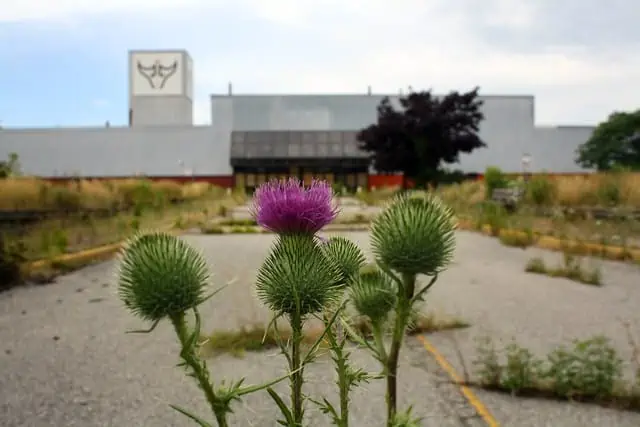Demolition (and partial preservation) of massive Knob Hill Farms site in Oshawa begins in June
Published May 28, 2024 at 12:29 pm

Long-awaited work to stabilize and preserve part of the former Knob Hill Farms site in Oshawa – the largest grocery store in Ontario when it opened in 1983 – will begin next month, with the rest of the 127-year-old building set to be demolished to make way for a new GO station.
Metrolinx purchased the property at 500 Howard Street in 2014 as part of the GO train expansion plans that will see two new stations built in Oshawa – including the central station at the Howard Street site – and two more in Clarington.
With a history dating back to 1872, the property has been identified as a provincial heritage property of “significance” and the plan is to preserve and repair the heritage component – the redbrick façade from an 1897 re-build of the Ontario Malleable Iron factory on the west side of the property facing Front Street – and demolish the rest of the massive structure.
The project has been on the wish list for the City since former Toronto Maple Leafs owner Steve Stavros abruptly closed the food terminal in 2000.
During the grocery warehouse’s heyday the site was home to a mammoth grocery store, a pharmacy, bakery, dentist’s office, video rental store, wine store and a card shop, with rail spurs running right to the building.
The west side of the building was home to an iron foundry from 1872 to 1977 and played a huge part in Oshawa and Canada’s industrial and labour history. It was the site of one of the country’s first strikes in 1900 and when the original plant was destroyed by fire in 1894 the New York Times called the company one of the most “important” industries in Canada.
There were strikes in 1940 (leading to a five-day, 45-hour work week and time-and-a-half for overtime) and in 1945 and 1966. Employees were locked out of the plant in 1976 over a pay dispute and never returned to their jobs as the plant was closed by owners ITT Grinnell 14 months later in the spring of 1977.
Since then the site abutting First Avenue has been forlorn and forgotten and far from first in the eyes of city planners, with several attempt to develop it – including earlier promises to build a GO station that fell flat due to remediation and land acquisition costs.

Part 1 of the structure will be preserved. Part 2 will be demolished
The portion of the structure being demolished was determined to have “no heritage value” after years of neglect and decay and has required on-site security for many years to reduce the risk of break-ins, fires, and vandalism.
Metrolinx said “specialized” crews will mobilize in June to begin the preservation and structural rehabilitation of the heritage component, a two-storey clay brick and wooden beam heritage structure.
Demolition of the rest of the structure (the main warehouse building and generator room) will follow, while continuing additional preservation activities of other heritage elements, which include structural rehabilitation and mothballing of the heritage component in its entirety.
Crews will be on site from mid-June to the fall between 7 a.m. and 4:30 p.m.
There is expected to be minor impact to pedestrians along adjacent sidewalks due to construction activities. Access to pathways and sidewalks will be maintained. There will be no anticipated traffic impacts from the work.

The redbrick façade from an 1897 re-build of the Ontario Malleable Iron Co. factory facing Front Street in Oshawa will be preserved when Metrolinx gets to work building a new GO Station on the site.
INdurham's Editorial Standards and Policies





